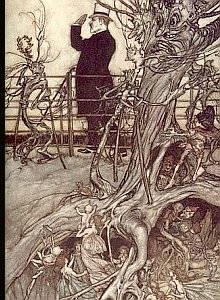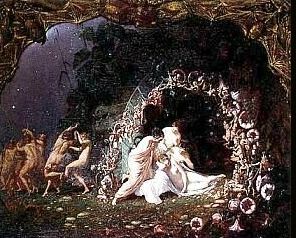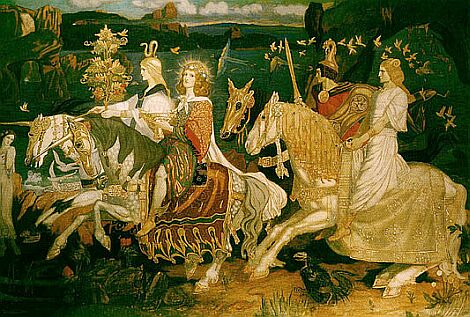

We are between
the worlds,
Beyond the bounds of time,
Where night and day,
Birth and death,
Joy and sorrow,
Meet as one.
STARHAWK
Witches work their magic in a special place between the worlds, a time outside of time. It is this technique which makes us supremely capable, above almost all other mortals, of entering into the Faerie Realm. The realm of Faerie is the place of enchantment and magic, and throughout history Witches have been frequent visitors to this world. Consorting with Faeries was even one of the many accusations levelled against them during the Witchcraze. According to Margaret Murray, author of The Witch Cult in Western Europe and The God of the Witches, in almost every case of Witchcraft from Joan of Arc in 1431 down to the end of the 17th century, the most damning evidence against the accused was aquaintance with the Faeries. But what exactly are Faeries? What do they look like? Where do they live? And most importantly, can a modern Witch still visit them?
What are Faeries?
When we hear the word Faerie most people think of little winged beings belonging to children’s story books, supernatural creatures who work magic and indulge in mischief. As we will soon see however, there is a lot more to them than this simple description.
There are many theories about the origin of Faeries, one of the most popular ones being David McRitchie’s famous ‘pygmy theory’ which was prevalent in the 1890’s. This was also subscribed to by Margaret Murray, who suggests in God of the Witches that Faeries were once real human beings. The Faeries, she says, were the descendants of the early people of Northern Europe. These dark-skinned survivors of the Stone Age were smaller than ‘mortals’ and lived in the wild, uncultivated areas of the country, they were herders of animals and unacquainted with agriculture. As civilisation advanced the Faerie population mingled more with the settled people until many of them entered the villages and became indistinguishable from other humans.
This euhemerising explanation for Faeries explains why they are small, fear iron (which they had not yet developed) and live in hillocks (round turf houses sunk in the ground). ‘Euhemerism’ is the idea that supernatural beings can be traced back to historical, factual people. This particular Faerie theory appears in Marion Zimmer Bradley’s novels about the Arthurian Legend, the popular Mists of Avalon series.
Many Folklorists of the early 20th century suggested that Faeries were the Pagan Gods, reduced in stature. As Christianity made inroads into Pagan societies the native deities lessened in importance, power and function. For example, the Faerie Queen Mab has much in common with the Celtic Goddess/Queen Maeve. The Green Knight (from the story of Gawain and the Green Knight) is often seen as a Pagan god, the Green Man. Celtic history records that the famous Irish deities, the Tuatha de Dannan, after the coming of Christianity, left the Earth’s surface and dwelt underground in hills or Neolithic graves and became known as the ‘Aes Sidhe’ the ‘People of the Hills’ or Faeries.
Traditional Witch, Nigel Jackson, suggests that Faeries are beings from the Underworld and that humans become Faeries after death. He explains that “the soul descends into the Faerie realm, sojourning as a Faerie in the Otherworld while awaiting the right cyclical patterns which will enable its Earthly rebirth to occur. The ‘human’ and the ‘Faerie’ are two poles of our own being, between which we oscillate back and forth through our cycle of rebirths. In other words, Faeries are ourselves awaiting birth and we are the Faeries awaiting our return to the Enchanted Realm.”
Irish peasants believed something similar to this up until around fifty years ago; women that died in chidlbirth, people that died young or children that became sicky and turned into ‘changelings’ were ‘away with the Faeries’. They were not dead however, they could be expected to return at any time and sometimes did.
|
|
 |
Yet another popular contemporary theory based on Jungian psychology is that Faeries are archetypal images created by a shared, common concern, they are personifications of birth, sex, fertility and death and are a way of approaching these subjects in symbolic form.
Perhaps Faeries are actually a combination of all of these ideas. English Witchcraft author, Doreen Valiente, suggests that Faeries might very well be composed of several factors: spirits of nature, Pagan deities, souls of the Pagan dead, folk memories of aboriginal races, and the widespread belief in an Underworld under the earth. No matter what these creatures are, Faeries exist in the realm between the worlds along with Elementals, Spirits, Angels and Gods and thus can be contacted by magickal practitioners who journey into such territory.
The Faeries’ appearance
The Faeries’ appearance will often reflect our own preconceptions of them, their forms are both manifold and varied. Sometimes they cannot be told apart from humans, at other times they resemble animals. They can be extremely beautiful or hideously ugly. In northern Scotland, Ireland, Brittany and France, the Faerie is the size of a human being and has all the characteristics of one. An Irish eyewitness from the 11th century recorded that “fifty Faerie women were seen with purple tunics and green hoods, and silver bracelets around their arms... All the women were of a like age and like shape, and like loveliness and like beauty and like straightness and like figure, in the dress of Faerie women, so that there was no telling one from the other.” There is no mention of whether they are human-sized or smaller which would suggest that they did not look particularly different to mortal women.
However, according to author/illustrators Brian Froud and Alan Lee, much of their external appearance is in fact glamour. Glamour is the magical garment of the Faerie and without it they appear as a shimmering light, it is a protective coverage and is often designed to make mortals believe they are dealing with one of their own kind. When inspected very closely, most Faeries are characterised by a physical deformity of some kind which marks them out as different. Such tell-tale signs include webbed feet, back-to-front feet, or even goat’s hooves, noseless nostrils, squint eyes, pointed ears and cow’s tails.
The Faerie Realm
There are special areas on Earth where the Faerie world and the mortal world meet, at these sites travel between the worlds can be experienced. Places such as trees, mounds, hills, caves, rivers, pools, wells, crossroads, boundaries, hedges, the bottom of the garden and of course Faerie Rings are all doorways to Faerie.
Probably the most well-known entrance to Faerie, the Faerie Ring, is a dark green circle on a lawn or in a field caused by the presence of fungi in the soil and the rings are often also outlined with mushrooms. These sites have long been reputed as magical places where occult power is concentrated and are therefore, favourite places for performing spells. Faerie Rings can apparently live for hundreds of years and some have been proved by modern science to be over 600 years old.
Like the Norse Yggdrasil, certain other trees which have their roots in the Underworld, are also entrances to Faerie. Three Hawthorn trees growing close together are thought to be especially potent. Other trees most favoured by them are the Blackthorn, Hazel, Alder, Elder and Oak, hence the saying: Turn your cloaks, for Faerie folks live in old oaks. Combinations of trees, especially if twisted together, are also powerful sites; two Thorns and an Elder for example or a group of Oak, Ash and Thorn. The Irish believe that a single tree in a field, or a group of trees on top of a Faerie hill belong to the Faeries and that it would be inviting disaster to chop them down.
 |
|
In The Book of the Dun Cow, the Faerie Queen describes her realm as the land of the ever-living, a place where there is neither death, nor sin, nor transgression. “We have continual feasts, we practice every benevolent work without contention. We dwell in large Sidhe and hence we are called the people of the faerie mound.”
Fairy mounds are entrances to the Pagan paradise, which might be located underground, under water, or under hills on distant islands across the western sea. An anonymous Irish author of the 11th century describes a visit to a Sidhe: ‘[A]s I gazed around me I saw a faerie hill, brightly lit, with many drinking horns and bowls and cups of glass and of pale gold in it, and I was staring at it for a long time at the doorway of the faery hill... I went across to the hill and sat down ... in a crystal chair on the floor and gazed at the house all around me, and I saw twenty-eight warriors on one side of the house with a lovely fair headed woman beside every man of them, and six gentle, youthful yellow-haired girls on the other side of the house, with shaggy cloaks around their shoulders; and a gentle yellow-haired girl in a chair on the floor of the house, with a harp in her hand which she was playing and continually thrumming. And every time she sang a song a horn was given to her to drink out of it, and she would give the horn into the hand of the man who gave it to her; and they were sporting and amusing themselves all around her.’
Irish people interviewed by Folklorists in the late 19th and early 20th centuries expressed the belief that the Faeries were ‘Fallen Angels’ who accompanied Lucifer out of Heaven, thus showing how Christianity eventually influenced, but did not destroy, Pagan belief.
Witches and Faeries
In the past Witches and Faeries were commonly thought to be the same thing and they often shared similar attributes such as the practice of magic, the ability to appear and disappear, shapeshifting, the preparation of magical ointments, dancing in circles and having wild night time revels. The Faerie Godmother in fairytales has many of the characteristics of the Witch and she often comes in a group of three sisters like the Witches’ Triple Goddess. Witches’ deities can interchange with Faerie royalty, examples being Puck, Robin Goodfellow, Robin Hood, Gwyn ap Nudd, Oberon, Morgan Le Fay, Dame Abundia, Habondia, Aradia, Diana, Venus, Hecate, Sybil and Titania. Doreen Valiente says that the leading female witch in a Scottish Coven was called the ‘Queen of Elphame’, a word which is the Scottish version of the Old Norse ‘Alfheim’, the country of the Elves or Faeries. Nigel Jackson tells us that ‘The traditional metaphysics of Elfland lie at the heart of true Witchcraft, a body of ancestral Faerie teachings and arts which formed a hidden tradition transmitted down the centuries across Europe and the British Isles.’
English Witches, Agnes Hancock in 1438 and John Walsh in 1566, said that they treated wounds made by fairy magic. John Walsh said that he consulted the ‘little people’ for advice between the hours of twelve and one in the afternoon and at midnight. Scottish Witch, Bessie Dunlop, in 1576 saw eight women and four men “the men were clad in gentleman’s clothing, and the women had plaids round them and were very seemly-like to see’. She was informed that they were ‘from the Court of Elfame’, and said that she had previously received a visit from the Queen of Elfame though without knowing at the time who her visitor was, she described the Queen as ‘a stout woman who came into her and sat down on the form beside her and asked a drink and at her and she gave it’. Bessie related how she was initiated and instructed by a Faerie man called Thom Reid who had originally died at the Battle of Pinkie and was now one of the Sidhe. He appeared in the form of ‘an honest well elderly man, grey bearded, and had a grey coat with Lombard sleeves of the old fashion; a pair of grey breeks and white shanks, gertered above the knee; a black bonnet upon his head... and a white wand in his hand.’
Alesoun Peirsoun in 1588 was ‘convict for haunting and repairing with the good neighbours and Queen of Elphane, and she had many good friends at that court which were of her own blood, who had good acquaintance with the Queen of Elphane’. Alesoun had been healed of a sickness and had become a healer herself through the agency of a green-clad Faerie man who came to her. Christine Livingstone said that ‘her daughter was taken away with the Faerie folk and that all the occult knowledge that she had was by her daughter who met with the Faeries’. One woman told the judges that ‘what skill so ever she has, she had it of her mother and her mother learned it at an Elf-man’. A Wizard called Andro Man said that he was the husband of the Queen of Elphane, with whom he lived for thirty-two years and by whom he had several children.

In 1623 Isable Haldane gave an account of how ten years earlier she had been caried out of her bed to a Faerie Hill which opened before her and that she spent three days in Elfland. She was brought out by a ‘man with a grey beard’ who was her Faerie teacher and companion and who aided her in divination, healing and cursing thereafter.
An unnamed Yorkshireman, accused of witchcraft in 1653 said that a Faerie had taken pity on his povertyicken condition and had admitted him to the Faerie Kingdom. There he had been shown how to administer a special Faerie powder to treat the sick and was thus enabled to make a living. In 1670 the witch Jean Weir described how the Queen of Faerie laid a spell upon her so that she could magically produce large amounts of yarn in a short space of time.
The most famous Witchcraft case dealing with Faeries was that of the Scottish Witch, Isobel Gowdie (d.1662), who confessed without torture (very unusual in Scotland) that she had been initiated as a Witch in 1647 by a ‘man in grey’. She described how she placed one palm on her head and the other under her feet and promised him everything in between. She then received the Witch name, Janet, and a Witches’ Mark on her shoulder. Isobel told of flying to the Sabbat on a bean stalk by putting it between her legs and saying ‘Horse and Hattock, horse and ho, horse and pellatis, ho, ho’.
She also described how she entered the Faerie Realm, ‘I was in the Downie Hills... the hills opened, and we came to a fair and large braw room in the day time... and I got meat there from the Queen of Faerie, more than I could eat. The Queen of Faerie is brawly clothed in white linen, and white and brown clothes: and the King of Faerie is a braw man, well favoured and broad faced. There were elf-bulls, routing and skoyling up and down there, and affrighted me.’
Up to as late as 1895 in Ireland, Bridget Cleary was attacked and burned to death by her deranged(?) husband because he thought she had been exchanged for a changeling by the Faeries of nearby Kylenagrangh Hill. The children of the district still sing the skipping chant: ‘Are you a Witch or are you a Faerie, or are you the wife of Michael Cleary?’
Evidently some other humans, not Witches, but those especially favoured by the Faeries are also allowed access to the Faerie Realm. Faeries are thought to especially favour gifted poets and bards, lactating women, young men and children. Thomas the Rhymer, a 13th century poet experienced enchantment of Faerie. One day, as he lay down on a river bank, the Queen of Elphame dressed in green rode past him on a horse whose mane was plaited with fifty-nine silver bells. Thomas was trapped by a kiss and taken on the back of the horse across deserts and rivers of blood to a green garden in Faerieland. An apple gave him the gift of prophecy and a tongue that could not lie. He lived with the Queen for seven years before he returned to earth to write poetry and make true prophecies. Some say he eventually went back and still lives on as an advisor to the Faerie court.
Illustrations on this page are by: Ida Rentoul Outhwaite; Arthur Rackham;
Richard Dadd; and John Duncan.
Published in Australia 1984 - 1990 - In Seattle & Sydney 1990-1994
Sydney/Seattle Webzine 1999
Copyright Shadowplay 2000. All rights reserved.
WebDesign: Rhea - Page last updated January 2002